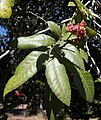
Alectryon is a genus of about 30 species of trees and shrubs from the family Sapindaceae. They grow naturally across Australasia, Papuasia, Melanesia, western Polynesia, east Malesia and Southeast Asia, including across mainland Australia, especially diverse in eastern Queensland and New South Wales, the Torres Strait Islands, New Guinea, the Solomon Islands, New Caledonia, New Zealand, Vanuatu, Fiji, Samoa, Hawaii, Indonesia and the Philippines. They grow in a wide variety of natural habitats, from rainforests, gallery forests and coastal forests to arid savannas and heaths.
Castanospora is a monotypic genus of trees, constituting part of the plant family Sapindaceae. The sole species Castanospora alphandii, commonly known as brown tamarind, grows naturally in the Australian rainforests of north-eastern New South Wales and eastern Queensland as far north as the Wet Tropics rainforests of north-eastern Queensland.

Arytera is a genus of about twenty–eight species known to science, of trees and shrubs and constituting part of the plant family Sapindaceae. They grow naturally in New Guinea, Indonesia, New Caledonia, Australia, the Solomon Islands, Vanuatu, Fiji, Samoa, Tonga; and the most widespread species and type species A. littoralis grows throughout Malesia and across Southeast Asia, from NE. India, southern China, Borneo, Malaysia, Singapore, Indonesia and the Philippines to as far east as New Guinea and the Solomon Islands.

Elattostachys is a genus of about 21 species of trees known to science, constituting part of the plant family Sapindaceae.

Litsea reticulata is a common Australian tree, growing from near Milton, New South Wales to the Bunya Mountains, Queensland. Common names include bollygum, bolly wood and brown beech. The habitat of the bollygum is rainforest of most types, except the dryer forms.

Citronella moorei is a rainforest tree growing in eastern Australia. Common names for this species include churnwood, citronella, soapy box, silky beech, and corduroy.

Diploglottis australis, known as the native tamarind, is a well known rainforest tree of eastern Australia. It is easily identified by the large sausage shaped leaflets.
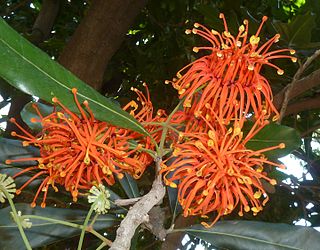
Stenocarpus sinuatus, known as the firewheel tree, is an Australian rainforest tree in the Proteaceae family. The range of natural distribution is in various rainforest types from the Nambucca River in New South Wales to the Atherton Tableland in tropical Queensland. Stenocarpus sinuatus is widely planted as an ornamental tree in other parts of Australia and in different parts of the world.

Jagera pseudorhus, commonly named foambark, is a species of rainforest trees, in the northern half of eastern Australia and in New Guinea, constituting part of the flowering plant family Sapindaceae. Named for the saponin foam that forms on the bark after heavy rain.

Backhousia leptopetala is a common Australian tree, growing from Stanwell Park in the northern Illawarra district to near Buderim in south eastern Queensland.
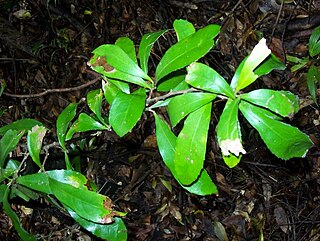
Helicia glabriflora is a species of rainforest shrubs or small trees occurring in eastern Australia. Common names include smooth or pale helicia, pale, leather or brown oak. They grow naturally in a variety of different rainforest types from the Illawarra, New South Wales to the Townsville area, Queensland. Of all the global diversity of approximately one hundred Helicia species, this one species naturally grows the furthest south, in the Minnamurra Rainforest and the Robertson area, Illawarra, New South Wales, there observed more on the relatively fertile basalt and alluvial soils.
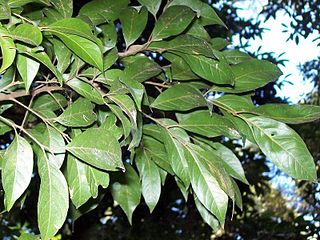
Sarcopteryx is a genus of about 12 rainforest tree species known to science, of the plant family Sapindaceae. They occur in Australia, New Guinea and the Moluccas.

Pseudoweinmannia lachnocarpa is a rainforest tree of eastern Australia. Common names include rose marara, mararie, scrub rosewood and red carabeen. The species name lachnocarpa is from the Greek, referring to the "woolly fruit". The genus name refers to the similarity of another genus, Weinmannia, after the German eighteenth century pharmacist J.W. Weinmann.

Litsea bindoniana, known as the big-leaved bollywood is a rainforest tree in the laurel family. A small to medium-sized bushy tree endemic to the rainforests of tropical Queensland, Australia. It features large leaves with attractive yellow venation, 25 cm (10 in) long by 10 cm (4 in) wide. They are dark green above, and paler and somewhat hairy below. The leaf stalks are hairy. The small greenish flowers are fragrant and occur from March to May. They are followed by fruits which mature from September to October, being a black drupe. Regeneration is from fresh seed, after removing the fleshy aril around the seed.
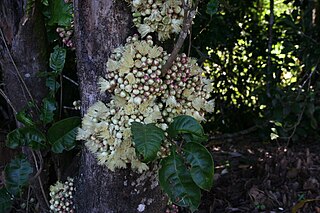
Syzygium cormiflorum, commonly known as the bumpy satinash, is a species of Syzygium tree endemic to Queensland in northeastern Australia.

Cupaniopsis wadsworthii, sometimes commonly named duckfoot and scrub tuckeroo, is an Australian species of shrubs of the flowering plant family Sapindaceae. The grow naturally in rainforests and seasonally dry rainforests, noted as usually "on hill slopes in rocky soil", from Magnetic Island southwards to about Bulburin National Park, central eastern Queensland.

Mischarytera is a genus of rainforest trees, constituting part of the plant family Sapindaceae. Four species are known to science as of December 2013, found growing naturally in eastern Queensland, Australia, and in New Guinea. Formerly until 1995, they had names within the genus Arytera, subgenus Mischarytera.
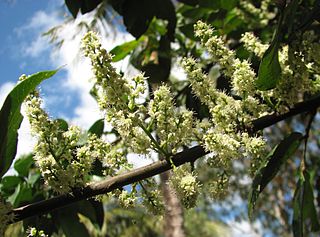
Guioa acutifolia is an evergreen tree from New Guinea and coastal areas of eastern Queensland in Australia. Common names include glossy tamarind, northern guioa and sharp-leaf guioa. It grows up to 20 metres high and has smooth, grey bark on its trunk which may be up to 15 cm wide. The sweetly scented flowers are produced between August and October in the species' native range Flowers and fruits often appear on immature trees.

Toechima daemelianum, commonly known as cape tamarind, is an evergreen tree from north-east Queensland in Australia. It grows up to 13 metres high and a trunk which may be up to 20 cm wide.
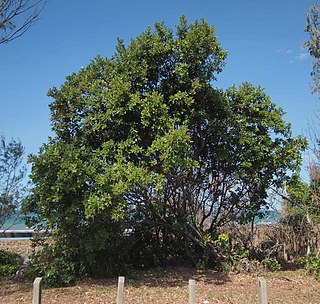
Alectryon connatus, sometimes named hairy alectryon, is a species of small trees, constituting part of the plant family Sapindaceae.

